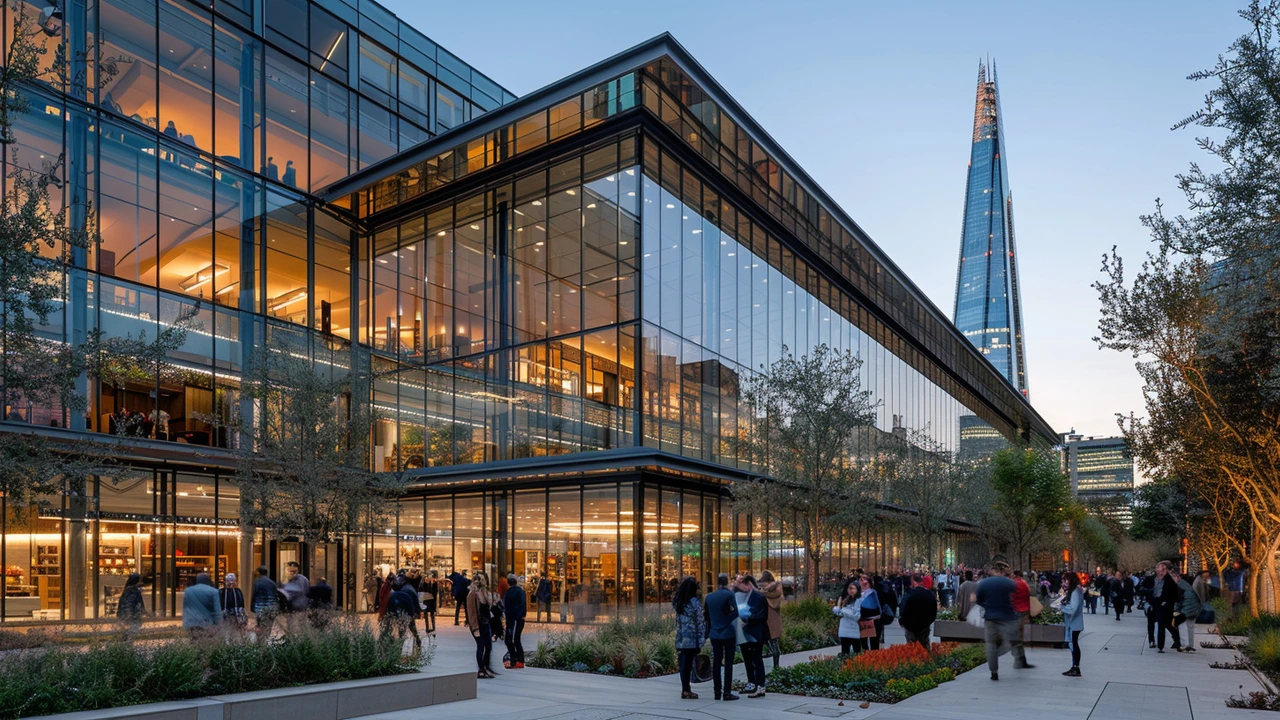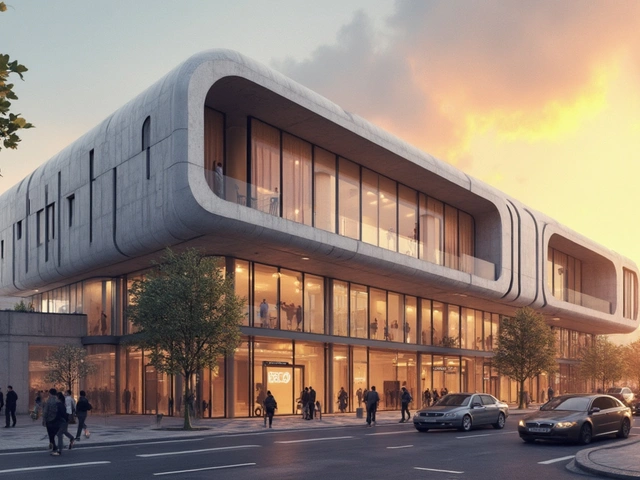International Style, with its sleek lines and minimalistic aesthetic, has dominated the architectural scene for nearly a century. Born out of the modernist movement in the 1920s and 1930s, this design approach has left an indelible mark on skylines around the world.
From its initial rise in Western Europe and the United States, International Style quickly gained traction due to its practical, unornamented approach. It emphasized functionality, simplicity, and the honest expression of materials. Architects like Le Corbusier, Ludwig Mies van der Rohe, and Walter Gropius championed this clean, efficient style, which found a foothold in both commercial skyscrapers and residential buildings.
Today, International Style continues to evolve, influenced by technological advancements and environmental considerations. Architects and designers blend its core principles with new ideas to create structures that are not only beautiful but sustainable and innovative. Whether you're an architecture enthusiast or someone looking to refresh your living space, understanding and embracing the International Style can offer timeless appeal and functionality.
- Historical Roots of International Style
- Key Characteristics and Principles
- Notable Architects and Projects
- Global Influence and Adaptation
- Modern Evolution and Innovations
- Tips for Incorporating International Style
Historical Roots of International Style
To understand the prominence of the International Style in architecture, one must travel back to the early 20th century. This period saw a global shift in cultural and social norms, driven in part by rapid industrialization and the aftermath of World War I. The architecture of this era echoed the desire for simplicity and functionality, a stark departure from the elaborate styles that characterized previous centuries.
The roots of the International Style can be traced to the early works of European architects who embraced modernist principles. The Bauhaus School in Germany, founded by Walter Gropius in 1919, was a significant incubator for this new approach. The school's ethos of merging art, craft, and technology led to the creation of structures that were both aesthetically pleasing and highly functional. The buildings designed during this period often featured flat roofs, smooth facades, and open floor plans.
"The ultimate goal of all visual arts is the complete building!" - Walter Gropius, founder of the Bauhaus School.
Another pivotal figure in the emergence of the International Style was the Swiss-French architect Le Corbusier. His manifesto, "Vers une architecture" (Toward an Architecture), published in 1923, laid out his vision for a new kind of architecture. Le Corbusier advocated for the use of modern materials like steel and concrete and championed an aesthetic characterized by clean lines and geometric forms. His famous dictum, "A house is a machine for living in," encapsulates the essence of his design philosophy.
Across the Atlantic, American architects were also beginning to adopt these modernist principles. One of the key events that brought International Style to the United States was the 1932 exhibition at the Museum of Modern Art (MoMA) titled "Modern Architecture: International Exhibition." Organized by architect Philip Johnson and historian Henry-Russell Hitchcock, this exhibition showcased key works of European modernism. It played a crucial role in popularizing the International Style in America, influencing a new generation of architects and designers.
As the style spread globally, it adapted to local contexts and conditions. In Brazil, for instance, architect Oscar Niemeyer merged the clean lines of the International Style with the curves and organic forms inspired by the Brazilian landscape. Similarly, in Japan, architect Kenzo Tange incorporated traditional Japanese elements into his modernist designs. This adaptability has been one of the reasons for the enduring appeal of the International Style.
The historical roots of the International Style are a testament to the power of innovation and the global exchange of ideas. Its emphasis on simplicity, functionality, and the honest expression of materials has left a lasting legacy on the world of architecture. Whether through the Bauhaus School's ground-breaking educational methods, Le Corbusier's pioneering theories, or the influential MoMA exhibition, the International Style has profoundly shaped our built environment.
Key Characteristics and Principles
The International Style is celebrated for its clean lines, open spaces, and absolute minimalism. At its core, this architectural style strips away unnecessary ornamentation to emphasize function and form. This means that every element in the design serves a specific purpose and contributes to the overall simplicity and efficiency of the space. One of the primary principles of the International Style is the use of rectilinear forms. Structures are often composed of geometrical shapes such as squares, rectangles, and cuboids. This emphasis on right angles and straight lines creates a sense of order and stability that is visually pleasing. The absence of elaborate facades and unnecessary decorations shifts the focus to the structure's form and materials. Modernist giants like Le Corbusier were advocates of this rational approach to design, famously stating that "a house is a machine for living in."
Another key characteristic is the use of open floor plans. Walls are minimized to allow for flexible spaces, creating a sense of continuity and flow within the building. This openness is not just about removing walls but also about maximizing the use of natural light. Large, expansive windows are a staple of the International Style, often utilizing steel frames that enable vast panes of glass. This focus on natural light not only reduces the need for artificial lighting but also fosters a connection with the surrounding environment.
The unadorned surfaces of International Style buildings often highlight the honest expression of materials. Instead of hiding structural elements behind decorative finishes, the materials themselves become a statement. Concrete, glass, and steel are frequently left exposed, celebrating their raw, natural beauty. This truthful use of materials aligns with the broader modernist philosophy of integrity and authenticity in design. In a world where appearances can often be deceptive, the International Style’s straightforward approach can feel refreshingly honest. Ludwig Mies van der Rohe, one of the key proponents, encapsulated this ethos with his famous phrase "less is more."
Functionality stands at the heart of this architectural style. Every aspect of the design is aimed at enhancing usability and optimizing space. For instance, built-in furniture like benches and storage units often feature prominently. This idea of functionalism extends beyond the individual building to the urban level, influencing cityscapes and residential developments. The thought process isn’t just about the aesthetic appeal but about how people will interact with the space, making it a pragmatic choice for both personal and commercial architecture.
A unique feature of the International Style is its embrace of technological advancements in construction techniques. The use of new materials and methods, such as reinforced concrete and curtain walls, allowed architects to break away from traditional load-bearing walls. This led to the creation of more open and airy spaces. The structural framework became independent of the external walls, allowing for greater flexibility in design and the incorporation of vast floor-to-ceiling windows.
One often overlooked aspect is the emphasis on volume over mass. Unlike traditional architecture, which focuses on the weight and solidity of the structure, the International Style prioritizes lightness and transparency. Buildings seem to float, with walls of glass letting light pour in and providing uninterrupted views. This characteristic is particularly evident in skyscraper designs, where the use of steel frames and glass facades lends an ethereal quality to urban landscapes.
| Characteristics | Principles |
|---|---|
| Rectilinear Forms | Functionality Over Ornamentation |
| Open Floor Plans | Honest Expression of Materials |
| Use of Glass, Steel, and Concrete | Embrace of Technological Advancements |
| Emphasis on Volume Over Mass | Maximizing Natural Light |
Understanding these key characteristics and principles can offer valuable insights into why the International Style has not only endured but evolved. Its emphasis on simplicity, functionality, and integrity resonates even in today’s fast-paced, high-tech world, making it a timeless choice for architects and designers alike.

Notable Architects and Projects
When discussing the International Style, it is impossible not to mention the luminaries who pioneered this influential architectural movement. The trinity often associated with its origin includes Le Corbusier, Ludwig Mies van der Rohe, and Walter Gropius. Their innovative designs and philosophical contributions set the foundation for this global architectural phenomenon.
Le Corbusier, a Swiss-French architect, is celebrated for his approach to clean lines and functional spaces. One of his most iconic works, Villa Savoye, constructed in 1931 in Poissy, France, embodies his five points of architecture: pilotis (supports), a flat roof terrace, open floor plan, horizontal windows, and free façade design. This modernist masterpiece, with its white, geometric structure, stands as a testament to his vision of a harmonious, efficient living space.
German-born architect Ludwig Mies van der Rohe brought the mantra 'less is more' into the forefront of the architectural world. His designs prioritised simplicity and open space, eschewing unnecessary embellishments. The Seagram Building in New York City, completed in 1958, is a prime example of Mies' ideology. Clad in bronze and glass, its sleek, minimalist design contrasts sharply with the ornamented buildings of its era, showcasing the beauty of pure form and function.
Meanwhile, Walter Gropius, another German architect, founded the Bauhaus School, which played a pivotal role in promoting the modernist movement. His collaborative approach blended fine arts and industrial design, creating functional structures that were also visually striking. One notable project is the Fagus Factory in Alfeld, Germany. Designed in 1911, its glass curtain walls and emphasis on practicality made it a precursor to many International Style buildings that followed.
Over the years, newer architects have continued to draw inspiration from these pioneers, adapting the principles to modern contexts. Richard Neutra, an Austrian-American architect, became renowned for his residential projects that seamlessly integrate indoor and outdoor spaces. His 1946 creation, the Kaufmann House in Palm Springs, is a striking example of this principle, characterised by clean lines, floor-to-ceiling glass, and a strong connection to its desert environment.
Many contemporary projects also reflect International Style's enduring legacy. Take, for instance, the Apple Park campus in Cupertino, California. Designed by Foster + Partners, this modern office complex is defined by its sleek, round structure and expansive glass walls, embodying the spirit of transparency and openness. It illustrates how International Style principles can be harmoniously merged with cutting-edge technology and environmental sustainability.
As we examine these varied and influential works, it becomes clear that the International Style is not just a relic of the past. It is a living, breathing approach to architecture that continues to inform and shape the spaces we inhabit today. In the words of Mies van der Rohe,
"Architecture is the will of an epoch translated into space."His perspective reminds us that while styles may evolve, the core values of design – simplicity, functionality, and beauty – remain timeless.
Global Influence and Adaptation
The influence of International Style architecture has truly spread across the globe in remarkable fashion. This modernist approach is often seen shaping not just urban landscapes in its birthplaces of Western Europe and the United States, but also in many other parts of the world. The hallmark clean lines, open spaces, and use of industrial materials have been adapted to different cultures and climates, resulting in an eclectic array of buildings that still remain true to their roots.
In Asia, for instance, cities like Tokyo, Hong Kong, and Singapore have embraced International Style, especially in their business districts. The sleek glass and steel skyscrapers are not only practical but also form modern urban aesthetics. These cities have managed to balance high-density living with thoughtful design, integrating green spaces and sustainable features.
Latin America has also seen a wave of International Style buildings, particularly in countries like Brazil and Mexico. The local adaptation respects traditional aesthetics while incorporating modernist principles. This blend is beautifully executed in works like the University City of Mexico, a UNESCO World Heritage Site that combines functional design with vibrant murals and artistic elements.
Africa, too, has not been left behind. Cities like Johannesburg and Nairobi are witnessing a surge in modernist architecture as they undergo urban renewal. These contemporary buildings reflect the blend of local culture and international trends, especially in efforts to innovate and create sustainable living spaces.
"International Style resonates because, at its core, it's about rationality and simplicity. That makes it adaptable to various contexts around the world,” says renowned architect Rem Koolhaas.
The Middle East offers another fascinating example. In cities like Dubai and Abu Dhabi, International Style has burgeoned through ambitious, large-scale projects. The Burj Khalifa, the tallest structure in the world, is an iconic representation of how modernist principles can reach stratospheric scales while incorporating local cultural elements and cutting-edge technology.
Even in smaller towns and residential areas worldwide, International Style has taken hold. The style's adaptability allows it to be scaled to different project types, from individual homes to large public buildings. One can see this in Scandinavian countries where new residential projects employ clean lines and functional spaces, just like International Style advocates.
The adaptability and influence of International Style also mean that it's not static; it continues to evolve. Architects and designers leverage advancements in technology and materials to push the boundaries of what this style can achieve, often focusing on sustainable and eco-friendly solutions. For instance, many modern International Style buildings now prominently feature solar panels, green roofs, and energy-efficient systems.

Modern Evolution and Innovations
The International Style has not remained static since its inception; it has undergone a significant evolution, blending with other architectural movements and technological innovations. Contemporary architects have embraced the core principles of the International Style such as simplicity, functionality, and the honest use of materials. However, they have also introduced new elements to meet modern needs and aesthetic preferences.
One of the key areas of evolution in International Style is the integration of sustainable practices. With the growing focus on environmental responsibility, architects are now incorporating eco-friendly materials and energy-efficient systems into their designs. For example, double-glazed windows, solar panels, and green roofs are features that marry the original minimalist aspects of International Style with modern sustainability goals. It isn't only about the look anymore; it's also about the ecological footprint left by the building.
Technology plays a critical role in the modern evolution of International Style. Advances in building materials, such as high-performance concrete and engineered timber, have expanded what architects can achieve. Moreover, building information modeling (BIM) is revolutionizing how architectural plans are designed, tested, and implemented. These technologies allow for more precise and efficient construction, reducing waste and costs while maintaining the clean, functional aesthetics of International Style.
There's also a noticeable shift towards adaptable and multi-use spaces. Unlike the early rigid structures, today's designs often incorporate elements that allow spaces to serve multiple functions. Walls can be moved, and sections of a building can be reconfigured to meet changing needs. This flexibility is particularly valuable in urban environments where space is at a premium.
A fascinating example of this evolution is seen in the work of contemporary architects like Jeanne Gang. Her designs, while grounded in the International Style, often include organic shapes and sustainable features. This blend of old and new can be strikingly beautiful and functional. In a 2023 interview, she noted, "Architecture is not just about implementing static buildings but about creating homes and offices that grow with their inhabitants."
"The future of architecture lies in balancing timeless design principles with the demands of a rapidly changing world," observes architect Rem Koolhaas.
Materials have also seen an upgrade. While glass and steel remain staples, architects now explore materials like cross-laminated timber (CLT) for their eco-friendliness and versatility. The natural aesthetic of timber can offer warmth and contrast to the stark metal and glass, creating a balanced look that is both modern and inviting. High-performance materials also enhance a building’s ability to withstand the elements and reduce maintenance costs.
Another notable trend is the incorporation of digital art and smart home systems into the International Style framework. Buildings are now equipped with systems that allow occupants to control lighting, heating, and security via smartphones. Digital art installations can adapt to the time of day or seasons, providing a dynamic and ever-changing visual experience.
Perhaps the most revolutionary aspect of the modern International Style is its global adaptation. While it originated in the West, architects worldwide have embraced and adapted the style to reflect their cultural contexts. In Japan, for instance, the minimalist principles have merged with traditional Japanese aesthetics to create serene and functional spaces. In Brazil, International Style buildings often incorporate vibrant colors and textures that reflect local culture.
In summary, the International Style has evolved significantly since its early days, driven by technological advancements and a growing focus on sustainability. Today’s architects continue to explore ways to blend its core principles with modern needs and preferences, ensuring this style remains as relevant as ever. Whether you are considering a new building project or simply appreciate good design, the modern evolution of International Style offers a wealth of inspiration and possibility.
Tips for Incorporating International Style
The International Style in architecture is known for its simplicity, functionality, and unadorned aesthetic, making it a timeless design choice for any building or home. Here are some practical tips to seamlessly integrate this style into your living or working spaces.
One of the key principles of International Style is minimalism. This means prioritizing open spaces and avoiding unnecessary details or decorations. Strive for a clean and uncluttered look. Think about using open floor plans which eliminate barriers and encourage a flow between different areas of your space. Large windows are another hallmark of this style, allowing natural light to flood the interior and creating a sense of connection with the outside world.
Another important aspect is the use of modern materials. Concrete, glass, and steel are the holy trinity of International Style. These materials aren't concealed but are emphasized to express their innate qualities. For instance, polished concrete floors or steel beams can be both structural and aesthetic elements. Combining these materials can create a sleek, industrial feel that is both modern and functional.
Flat roofs are a common feature in International Style architecture. Unlike traditional pitched roofs, flat roofs contribute to the geometric, clean lines that define this style. If you're building new or renovating, consider opting for a flat roof. It’s not only an iconic element but can also create more usable outdoor space, perfect for a rooftop garden or terrace.
Furniture and decor should align with the minimalist theme. Choose pieces with clean lines, simple shapes, and neutral colors. Functional furniture like modular sofas and minimalist shelving that blend form and function work best. Avoid ornate designs and intricate patterns. Instead, focus on quality and craftsmanship.
Color schemes in International Style are typically subdued, sticking to a palette of whites, grays, blacks, and natural earth tones. This doesn’t mean your space has to be devoid of color. Accents and artwork can introduce pops of color, adding personality without overwhelming the simplicity of the design. An accent wall in a bold color or a piece of modern art can serve as focal points while maintaining the overall serene atmosphere.
Sustainability is increasingly becoming a key focus within International Style. Solar panels, energy-efficient windows, and green roofs can be integrated into the design without compromising the aesthetic. Architects are blending modern technology with the core principles of the style, resulting in buildings that are both stylish and environmentally friendly.
Lighting plays a crucial role. Use track lighting or recessed lights to highlight key areas and features. Pendant lamps with simple, geometric designs can also add elegance. Remember, the goal is to enhance the space without drawing too much attention to the fixtures themselves.
As architect Ludwig Mies van der Rohe famously stated, "Less is more"—a mantra that perfectly encapsulates the essence of International Style.
Lastly, consider the landscaping around your building or home. The exterior should complement the minimalist design of the structure. Think about using native plants that require minimal care and irrigation. Gravel paths, simple geometric shapes, and uncluttered outdoor spaces can extend the design principles of the International Style to the property’s exterior.
By focusing on these elements, you can create a space that is both visually appealing and functional, embodying the timeless appeal of International Style. Whether you are starting from scratch or looking to make some changes to an existing space, these tips provide a solid foundation for incorporating this iconic architectural style into your home or office.





